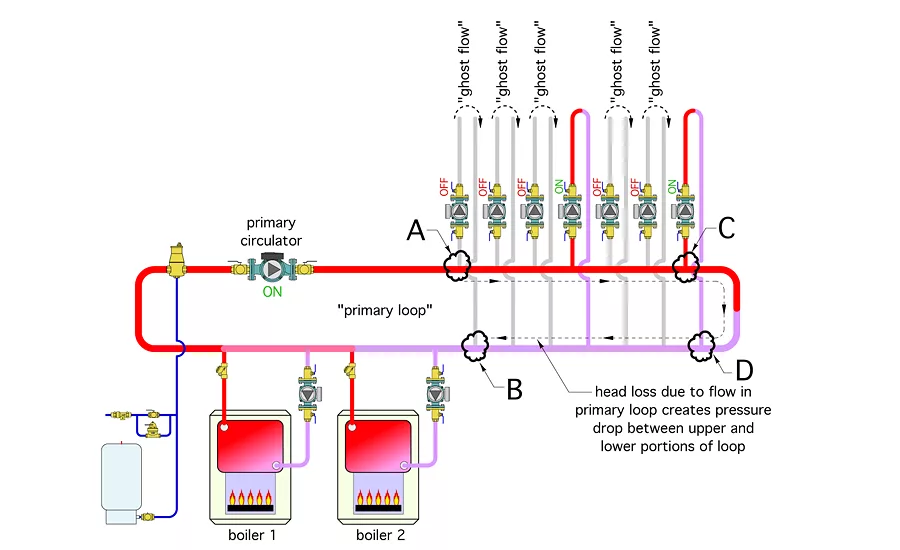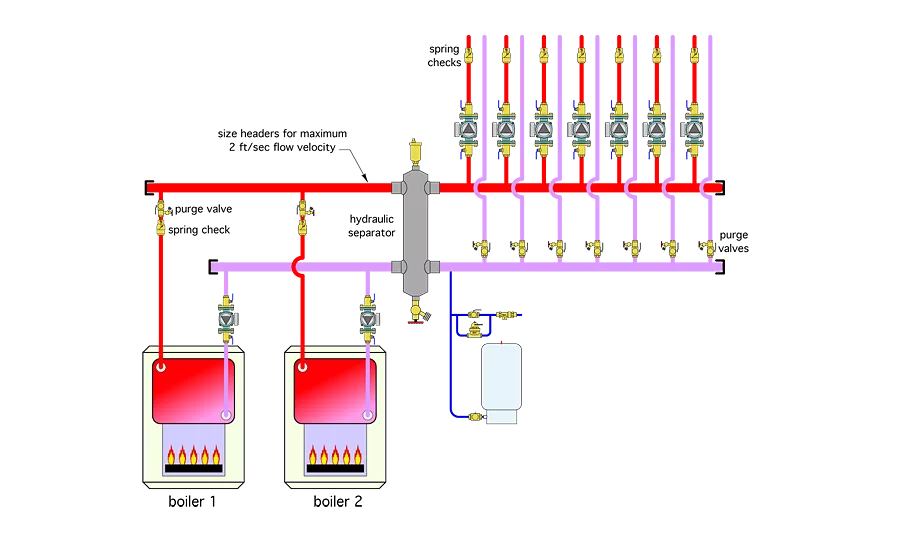How to eliminate ghost flow and recirculation issues
Don’t repeat design mistakes.



Einstein’s definition of insanity was doing the same thing over and over and expecting different results. If that’s true, there are definitely some “insane” hydronic system designers in North America. They repeatedly cling to certain piping layouts, even though existing projects using those layouts have experienced problems.
One incorrect piping layout that I’ve seen repeated many times could be described as a morphing of primary/secondary piping and a classic header-type multizone distribution system. I’ve seen it as installed hardware and in neatly prepared CAD drawings created by professional engineers. The latest rendition of this problematic piping layout popped up in an email sent to me for review. My conclusion: It’s time to write about this problem — again — and try to dissuade others from repeating it.
The piping error that I’m referring to is represented by Figure 1.
This system is neither primary/secondary nor a header-type multizone system. It’s undefined among proven hydronic piping designs.
My guess as to how this aberration comes to be is that a designer starts with the idea of primary/secondary piping and therefore thinks he needs a primary loop. The heat source(s) will inject heat into this loop and the load circuits will extract heat from it.
So the designer sketches out the loop and puts in a primary loop circulator. Next it’s time to add some load circuits, and this is where the designer’s memory flashes back to neatly aligned zone circulators all lined up on a wall. With that in mind, the designer connects the supply side of each zone circuit to the upper part of the loop (thinking it’s a header) and the return side to the lower portion of the loop (again viewing it as a header). The fact that the headers are connected at their ends doesn’t seem to matter because that part of the piping is seen as part of the primary loop “foundation” of the system.
Think like water
So, what’s wrong? One problem with this design can be envisioned if you consider the pressures within the primary loop when only the primary loop circulator is operating. There’s a pressure drop between the upper portion of the loop, where the supply side of the load circuits connect, and the lower portion of the loop, where the return side of the load circuits connect. This is illustrated in Figure 2.
If just the primary circulator was running, the pressure differential would be highest between points A and B due to the head loss along the longest loop path. It would decrease to some minimum value between points C and D. However, the pressure differential across any given load circuit at any given time also will be influenced by the on/off status of the other load circulators and thus highly variable. Still, it’s possible the pressure differential between points where a load circuit begins and ends could be several pounds per square inch.
Now, as my colleague Dan Holohan suggests: Think like water! If the pressure at point A is higher than the pressure at point B, the water wants to move from A to B. And if there’s no component in the load circuit path that blocks it, water will follow its instincts and flow from A to B.
The result is heat delivery into a zone circuit in which the circulator is off and heat delivery is not needed. Call it heat migration, ghost flow or whatever you want. It’s not supposed to occur and customers have every right to complain when it does.
It’s conceivable that all the zone circuits could have some flow through them when only one zone is actually calling for heat. Flow would occur in any load circuit where the forward opening resistance of any check valve (which is typically 0.3 to 0.5 psi) is smaller than the developed pressure differential between the supply and return sides of the load circuit.
The rate of undesirable heat migration depends on the pressure differential between the supply and return of each zone circuit, and the amount of recirculation mixing that occurs. The latter depends on the flow rate in the primary loop vs. the flow rates in the load circuits.
If flow is rocketing through the primary loop — because someone thinks the primary loop flow has to be at least equal to the sum of the load circuit flows (which is incorrect) — then recirculation mixing won’t occur. However, if the flow in the primary loop is less than the sum of the active load circuit flow rates, there is sure to be recirculation somewhere. Again, think like water. Why should the water travel all the way back to where the boiler(s) are connected to the primary loop if it can just take a shorter detour and end up back at the inlet of a load circulator?
If you’re going to build a true primary/secondary system, each load circuit and each heat source need to connect to the primary loop using a pair of closely spaced tees. These tees isolate the pressure dynamics of each circulator from the other circulators in the system.
This effect is called hydraulic separation.
I draw it like I see it
The system shown in Figure 1 accurately represents a drawing I received. Aside from the morphed piping layout, several other details are of concern:
-
No check valves are installed in the load circuits to prevent reverse flow when some loads are active while others are not.
-
There are no purging valves in the load circuits.
-
A swing check valve is mounted in a vertical pipe coming from the boiler. Swing check valves should never be mounted in vertical piping. Under some conditions, the flapper can hang in the open position when flow stops and slam shut when sufficient reverse flow develops. This can cause a strong water hammer effect.
-
The tees connecting the boilers to the primary loop should be as close together as possible. The pressure drop in the tees, as shown in Figure 1, will tend to induce some flow through an inactive boiler. This results in increased heat loss from the boiler jacket due to convective air currents in the venting system.
Lose the loop
I can attest that properly designed primary/secondary systems work. We’ve designed many of them over the years. Still, in my opinion, better options are now available that provide the benefits of primary/secondary piping, but with simpler and less expensive piping configurations. One example is shown in Figure 3.
This system connects the boilers to a header system leading to a hydraulic separator. The load circuits connect to short/generously sized headers leaving the right side of the hydraulic separator. High-performance air and dirt separation are provided by the coalescing media inside the hydraulic separator. This eliminates the need for air and dirt separators as individual components.
By keeping the headers short and generously sized, the pressure drop along the header is minimized. This effect works in concert with the very low pressure drop within the hydraulic separator so that all circulators in the system operate as if they were isolated from each other.
My suggestion is to size the headers so the flow velocity within them doesn’t exceed 2 ft. per sec. when carrying their maximum flow rate.
This piping layout eliminates the ghost flow and possible recirculation issues previously described. It provides equal supply temperatures to each of the load circuits. It does away with the primary loop circulator and, perhaps most importantly, it eliminates the operating cost of a primary loop circulator over the life of the system. The savings associated with the latter could easily add up to more than the cost of the hydraulic separator.
So please, don’t repeatedly prove that Einstein was right about insanity. If you’re intent on building a primary/secondary system, be sure you construct it with closely spaced tees and a properly sized primary circulator.
If you’re open to suggestions, consider the use of a hydraulic separator to achieve the benefits of a primary/secondary system with simpler piping and lower life-cycle operating cost.
This article was originally titled “Don’t repeat design mistakes” in the August 2016 print edition of Plumbing & Mechanical.
Looking for a reprint of this article?
From high-res PDFs to custom plaques, order your copy today!





